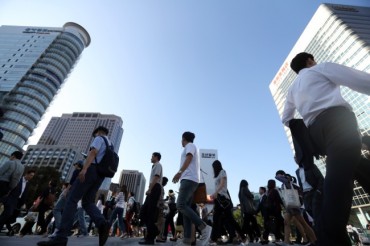
When an employee at a large-sized company receives 1 million won (US$880), a worker at a small-sized firm makes only 326,000 won. (image: Korea Bizwire)
SEOUL, Apr. 22 (Korea Bizwire) — A recent study has revealed that employees of large-sized companies in South Korea make three times as much as workers at small companies with fewer than four staff members, and that the income gap has widened over the last five years.
In contrast, Japan has been making efforts to close in the income gap between employees at large and small firms.
The Korea Small Business Institute (KOSBI) announced on Sunday that employees working at companies employing one to four staff members make only 32.6 percent of the average income made by staff at companies with more than 500 employees.
This means that when an employee at a large-sized company receives 1 million won (US$880), a worker at a small-sized firm makes only 326,000 won.
Those employed by businesses with between five and nine staff members only earn 48.3 percent of what employees at large-sized companies make every month, while those working at companies with 10 to 99 or 100 to 499 staff members make 57.2 percent and 70 percent, respectively, of the monthly income of workers at large-sized companies.
In contrast, the average income of workers at businesses with one to four staff members in Japan is 65.7 percent of the income that employees hired by companies with more than 500 staff members make.
Those working at companies with five to nine, 10 to 99, or 100 to 499 employees in Japan make 77.1 percent, 83.8 percent, and 87.8 percent, respectively, of the total income earned by employees at large-sized companies, easily surpassing small-sized companies in South Korea.
The income gap between workers at large-sized and small-sized companies in South Korea has also widened in the last five years.
Employees at small-sized companies with one to four staff members in South Korea made 1.1 percent less income this year in proportion to the average income at firms with more than 500 employees, indicating a widening income gap between the two companies, KOSBI said.
Employees hired by businesses with five to nine, 10 to 99, and 100 to 499 staff members made 2.4 percent, 2.6 percent, and 2.6 percent less than last year in proportion to the average income at large-sized companies.
In contrast, small-sized firms with one to four or five to nine staff members in Japan earned 5.3 percent more in proportion to large-sized companies.
Businesses with 10 to 99 or 100 to 499 staff members closed the income gap by 6.1 percent and 2 percent, respectively, this year.
“Closing the income gap between workers at small and large-sized companies requires policies that encourage employees at small-sized firms to work for longer terms, and promote mutual growth among staff members,” said Roh Min-seon, a researcher at KOSBI.
“Efforts should be made to achieve coexistence with partner companies as well.”
H. M. Kang (hmkang@koreabizwire.com)






